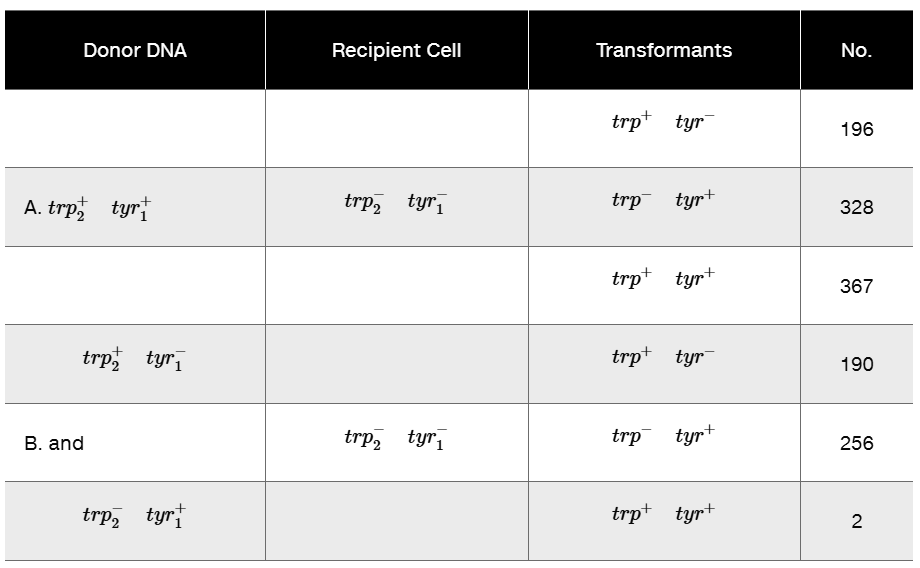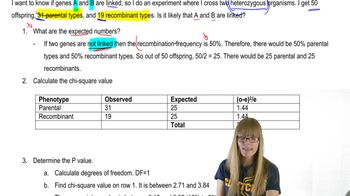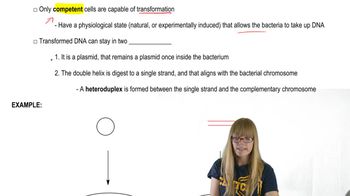Describe the role of heteroduplex formation during transformation.
Table of contents
- 1. Introduction to Genetics51m
- 2. Mendel's Laws of Inheritance3h 37m
- 3. Extensions to Mendelian Inheritance2h 41m
- 4. Genetic Mapping and Linkage2h 28m
- 5. Genetics of Bacteria and Viruses1h 21m
- 6. Chromosomal Variation1h 48m
- 7. DNA and Chromosome Structure56m
- 8. DNA Replication1h 10m
- 9. Mitosis and Meiosis1h 34m
- 10. Transcription1h 0m
- 11. Translation58m
- 12. Gene Regulation in Prokaryotes1h 19m
- 13. Gene Regulation in Eukaryotes44m
- 14. Genetic Control of Development44m
- 15. Genomes and Genomics1h 50m
- 16. Transposable Elements47m
- 17. Mutation, Repair, and Recombination1h 6m
- 18. Molecular Genetic Tools19m
- 19. Cancer Genetics29m
- 20. Quantitative Genetics1h 26m
- 21. Population Genetics50m
- 22. Evolutionary Genetics29m
5. Genetics of Bacteria and Viruses
Bacterial Transformation
Problem 23
Textbook Question
In Bacillus subtilis, linkage analysis of two mutant genes affecting the synthesis of two amino acids, tryptophan (trp₂⁻) and tyrosine (trp₁⁻), was performed using transformation. Examine the following data and draw all possible conclusions regarding linkage. What is the purpose of Part B of the experiment? [Reference: E. Nester, M. Schafer, and J. Lederberg (1963).]

 Verified step by step guidance
Verified step by step guidance1
Step 1: Understand the experimental setup. In this experiment, Bacillus subtilis is used to study the linkage between two mutant genes affecting the synthesis of tryptophan (trp) and tyrosine (tyr). Transformation is the method used to introduce donor DNA into recipient cells, and the resulting transformants are analyzed for their phenotypes.
Step 2: Analyze the data provided. The table lists the phenotypes of the transformants and their respective numbers. The phenotypes include combinations of wild-type (trp⁺, tyr⁺) and mutant (trp₂⁻, tyr₁⁻) alleles. The numbers indicate the frequency of each phenotype among the transformants.
Step 3: Determine the purpose of Part B of the experiment. Part B involves analyzing specific combinations of donor and recipient DNA to assess the frequency of co-transformation of the trp and tyr genes. This helps determine whether the genes are linked (located close together on the chromosome) or unlinked (located far apart).
Step 4: Use the data to infer linkage. If the trp and tyr genes are linked, co-transformation (simultaneous transfer of both genes) will occur more frequently than expected by chance. Compare the observed frequencies of co-transformed phenotypes (e.g., trp⁺ tyr⁺) to the frequencies of single-gene transformations (e.g., trp⁺ tyr⁻ or trp⁻ tyr⁺).
Step 5: Draw conclusions about linkage. If the frequency of co-transformation is significantly higher than expected for unlinked genes, this suggests that the trp and tyr genes are linked. Conversely, if the frequencies of co-transformation and single-gene transformations are consistent with independent assortment, the genes are likely unlinked.
 Verified video answer for a similar problem:
Verified video answer for a similar problem:This video solution was recommended by our tutors as helpful for the problem above
Video duration:
3mPlay a video:
Was this helpful?
Key Concepts
Here are the essential concepts you must grasp in order to answer the question correctly.
Linkage Analysis
Linkage analysis is a genetic technique used to determine the proximity of genes on a chromosome based on the frequency of recombination between them. Genes that are located close to each other tend to be inherited together, while those farther apart are more likely to be separated during meiosis. This method helps in mapping genes and understanding their interactions, particularly in organisms like Bacillus subtilis.
Recommended video:
Guided course

Chi Square and Linkage
Transformation
Transformation is a process by which a cell takes up foreign DNA from its environment, leading to genetic changes. In the context of Bacillus subtilis, transformation allows researchers to introduce specific mutations or genes into recipient cells, enabling the study of gene function and interactions. This technique is crucial for analyzing how different genes affect metabolic pathways, such as amino acid synthesis.
Recommended video:
Guided course

Transformation
Amino Acid Synthesis
Amino acid synthesis refers to the biochemical processes through which organisms produce amino acids, the building blocks of proteins. In Bacillus subtilis, specific genes are responsible for the synthesis of amino acids like tryptophan and tyrosine. Understanding the genetic basis of these pathways is essential for interpreting the results of linkage analysis and determining how mutations in these genes affect overall metabolism and growth.
Recommended video:
Guided course

Translesion Synthesis


